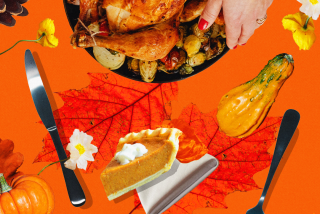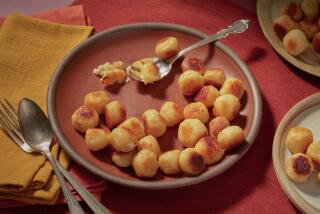Thanksgiving Family Secrets : Panicky Popovers
- Share via
My mother claimed to enjoy holiday entertaining, but if this was so, she enjoyed it the way athletes enjoy a big race or actors enjoy a major performance: She liked mounting tension and a last minute rush of adrenaline, the bigger the better. Which is to say, after the turkey was roasted, the potatoes mashed, the onions creamed, the rutabagas pureed, the cranberries gelled, the pies baked--just when there was a scant hour before we sat down to eat--she had to make a batch of popovers.
It would seem, for a while, that the success of the whole dinner depended on whether or not these most temperamental of bread products actually “popped”--although sometimes this tension was eclipsed by whether or not my Uncle Wes would arrive suitably dressed for company.
On Thanksgiving, I’d wake up early and help Mom get the turkey into the oven. My sister and I had the job of tearing bread slices for the dressing and I had the dubious honor of pulling pin feathers out of the bird. I might peel potatoes or wipe water marks off the silverplate, but basically, my mother’s kitchen a one-woman show. My father ran errands for her--fetched ice, last-minute groceries, liquor--and invariably stayed away far longer than she thought he should, leaving her stalled midway through a cream sauce or a mincemeat.
*
I remained in the kitchen as long as I could, watching in fascination as she stitched the turkey shut and set the guts to boil on the stove. Sooner or later, in the assembling of cranberry aspic with walnuts and sour cream, green salad or baked yams, my constant inquiries annoyed her.
“Art,” she’d call. “Do something with the girls.”
By noon, the atmosphere in the kitchen was so tense, you couldn’t get near it without gasping for air. I could hear her moving in there: the creak of the stove, a low and continuous muttering punctuated by sharp epithets, the shoving of pots and pans, and an occasional cry to my father.
“ Arrrrt . . . I told you to buy half and half. This is whipping cream!”
*
My father would brave the fray, locate the half and half which he’d put on the wrong shelf in the refrigerator, and come out looking something like Woody Allen emerging from the Orgasmatron. For the most part, we--my sister, my father and I--laid low.
When the end was in sight, my dad would slip out to go pick up his brother Wes.
My mother would catch him on his way out. “Art, I want you to make sure your brother is decently dressed this time.” (Wes, the family eccentric, dressed with a flair my mother did not always appreciate).
Anyway, by the time my dad was en route to get Wes, the turkey was out of the oven, the guests were beginning to arrive and it was suicide to go anywhere near the kitchen, my mother would start her popovers.
Popovers aren’t hard to make. A cup of milk, a cup of flour, two eggs, some butter. Dash of salt. My mother had an antique popover pan she’d bought in Port Angeles, Wash. It held 11 popovers.
*
She would only make one batch; her mother would bring homemade yeasted rolls. But Mom loved popovers and wanted popovers and also maybe wanted to raise the pitch of tension one more notch--at any rate, nobody could talk her out of it.
Once the popovers were in the oven, she’d pour herself a drink and sit down with whatever guests had arrived, although she’d be up and down, peering in the oven’s window, fretting if the popovers would pop. Most of the time, they did, just like they’re supposed to: They popped into little balloons of lovely, buttery crust, the interior hollow with moist, custardy walls.
One year, however, she used margarine instead of butter, and she pulled out squat little brown plugs. Other times, they didn’t pop much. I was the one who passed judgment on whether they were popovers or pop-unders.
One Thanksgiving, I picked Wes up and drove him over to our house. I had made the ritual promise to my mother that he would be dressed well and I thought he looked just fine: a white sweater with red snowflakes, reasonably clean, and a pair of old wool dress slacks, also reasonably clean. We arrived just after my mother had put the popovers in the oven. The turkey was resting on the carving platter. She’d poured herself a Scotch and we were all sitting uneasily in the living room waiting for other guests to arrive. She’d already gotten up once to see if the popovers were popping but it was too early to tell. I sat next to Wes on the sofa. My mother was talking anxiously.
*
“Don’t let me forget to put the butter and jam out. And wineglasses? Oh, and I’ve got sour cream for the cranberries . . . “
Her voice trailed off. She was staring at Wes’ ankles. Soon, we were all looking down toward Wes’ feet, where a ruffle of cloth emerged from his pants cuffs.
“Wes,” my mother said sharply. “Are you wearing two pair of pants?”
He looked down at the telltale ruffle, then slowly up at my mother. He knew he had to come up with a good explanation, or she’d go through the roof before our very eyes.
“The first pair was dirty,” he said.
As if on cue the oven timer went off: time to turn down the heat on the popovers.
Lucky for us, they’d popped.
*
I’d been living on my own and cooking for years before I attempted a popover. After all those Thanksgivings, I thought they were as delicate and testy as the most temperamental souffles. I was stunned to discover they were only a little iffy. There are all sorts of techniques, I discovered--starting in a cold oven, starting in a hot oven and turning down the heat, beating the eggs with the milk and adding flour, beating the milk with the flour and adding eggs. Almost all these methods have pretty good success rates. I also became fond of making one huge popover, really a kind a Yorkshire pudding without meat drippings, which for years I served as a breakfast treat, usually to guests.
The only time popover technique really became an issue for me was recently, when we tried to make my one huge popover in a skillet in The Times Test Kitchen. We produced failure after failure: flop-overs, I called them. (It should be noted that even the flattest, least inflated versions were avidly devoured by everyone who tasted them.) Back in my own kitchen, I made one more flop and then got down to business, reading cookbooks, and trying to remember how I used to make the giant thing. I finally tried a casual version of the Yorkshire pudding recipe in “Joy of Cooking” and by mixing the ingredients differently than for a regular popover, and altering the cooking temperature and time, I finally hit gold. Pulling that big crusty, buttery bubble from the oven, I felt like my mother on a triumphant Thanksgiving afternoon calling out to all assembled. “All right. Let’s eat!”
*
Here is my mother’s recipe, ever so slightly adapted from the “Settlement Cookbook.”
POPOVERS
1 cup flour
1/4 teaspoon salt
2 eggs
1 cup milk
1 tablespoon butter, melted
Sift flour and salt into bowl. Beat eggs with rotary beater in separate mixing bowl and add milk and butter. Sift in flour-salt mixture, then beat only enough to make smooth batter.
Fill hot buttered muffin tins 1/3 full of mixture. Bake at 450 degrees 30 minutes, then reduce temperature to 350 degrees and bake 15 more minutes or until firm, brown and popped. Keep oven door closed while baking. Makes 13 popovers.
Each popover contains about:
61 calories; 74 mg sodium; 36 mg cholesterol; 2 grams fat; 8 grams carbohydrates; 3 grams protein; 0.03 gram fiber.
*
This recipe is adapted from the Y orkshire pudding recipe in “ Joy of Cooking. “ I say that it makes four servings, but two good eaters can dispatch one whole recipe painlessly. Don’t worry if this flops: It still tastes great, and makes a perfect buttery vehicle for your favorite preserves.
ONE GIANT POPOVER
1 cup flour
1/4 teaspoon salt
1 cup milk
2 eggs
1 to 1 1/2 tablespoons butter
Place 10-inch cast-iron skillet in 400-degree oven.
Sift flour and salt into mixing bowl. Add milk and beat on medium speed with electric mixer until smooth. Add eggs, 1 at time, and continue beating until large bubbles come to surface when you momentarily pause beating process, about 30 seconds.
Put butter in heated skillet still in oven and allow butter to melt without browning. (Open oven as little as possible to keep oven hot.) Make sure butter coats bottom and sides of pan. Quickly pour batter into skillet. Bake at 400 degrees 20 minutes, then reduce heat to 350 another 15 to 20 minutes. Serve immediately with jam and butter, if desired. Makes 4 servings. Each serving contains about:
198 calories; 239 mg sodium; 119 mg cholesterol; 7 grams fat; 25 grams carbohydrates; 8 grams protein; 0.09 gram fiber.
More to Read
Eat your way across L.A.
Get our weekly Tasting Notes newsletter for reviews, news and more.
You may occasionally receive promotional content from the Los Angeles Times.










